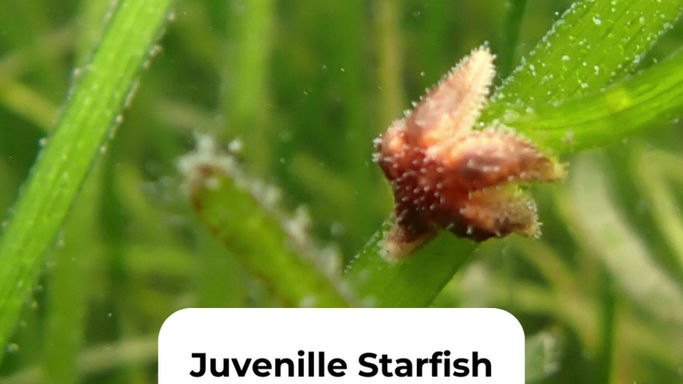
Restoration Forth - Seagrass
Project Background
The Restoration Forth Project is a multi-year project which endeavours to re-establish native habitats within the Firth of Forth. The project is focused on restoring populations of both seagrass and the European flat oyster.
The first phase of Restoration Forth (2022-24) was made possible by funding from Aviva, the Moondance Foundation, the ScottishPower Foundation and the Scottish Government’s Nature Restoration Fund, facilitated by the Scottish Marine Environmental Enhancement Fund, and managed by NatureScot.
The current phase of Restoration Forth is made possible by funding from Sky and the Cinven Foundation; the project is supported by the Scottish Government’s Nature Restoration Fund, managed by NatureScot.
Restoration Forth Slider
Restoration Forth Slider


Restoration Forth 2023

Seagrass Planting 2024

World Seagrass Day 2024

Seagrass Planting 2025

Lewis Jefferies Photography
Meet Lyle
My role over the next few years is to raise awareness of the ecological importance of seagrass meadows and the benefits that these habitats can provide local communities.
The objective of Restoration Forth is to give community organisations and individuals within Fife the agency to take ownership of their local marine environment, in order to secure its integrity into the future.
So if you are interested in learning more about seagrass and want to get involved in an exciting marine restoration project, please feel free to drop me a line. My email address is lyle@theecologycentre.org
Keep up to date - Seagrass Blog

The Forth
The Firth of Forth was once a thriving marine ecosystem which supported a mosaic of native habitats and species, however, centuries of transformative activities and large scale industrialisation along its banks, has led to a shift in the environmental landscape
The Forth formally supported an expansive oyster reef until our appetite surpassed their natural restocking ability, and as a consequence there are virtually no remaining oysters in the Forth today. Moreover, the extent of seagrass meadows present in the Forth are considered to be a fraction of their historic extent.
Restoration Forth intends to initiate the rejuvenation process of the Forth, by re-introducing these two species in greater densities it is hoped that these populations will be able to self-seed and propagate naturally, bringing with them beneficial ‘ecosystem services’ and encouraging an increase in biodiversity.
The UN has designated this next decade, as the decade of ecosystem restoration in response to the acceleration of habitat loss. Restoration Forth is a project that aims to champion the incentives outlined by this UN initiative.

What is Seagrass?
Seagrass is unique within the marine environment as they are the only true flowering plants (angiosperms), unlike seaweeds, seagrass flowers, develops fruit and expels seeds. Over millennia seagrass has adapted to the harsh saline conditions of the sea and have since gone on to spread widely around the globe, with seagrass species found in every continent apart from Antarctica. There are approximately 60 species of seagrass found around the globe, however, in the UK there are two recognised species of seagrass; eelgrass (Zostera marina) and dwarf eelgrass (Zostera noltii). These unassuming species are responsible for a number of ‘ecosystem services’; which are the direct and indirect contributions of ecosystems to human wellbeing, that impact on our survival and quality of life. The ecosystem services provisioned by seagrass include but are not exclusive to; sequestering carbon dioxide, improving water quality, preventing coastal erosion and providing habitat to a range of species. Seagrass’s ability to trap and store carbon in the sediments that they create has been identified as one of the many solutions to combating climate change.
Seagrass meadows have seen a sharp decline in their extent over the past century, with UK meadows declining between 50 and 90% during this time. It is vital that we give these habitats a fighting chance, by actively restoring seagrass meadows we can alleviate global biodiversity loss and mitigate climate change.
These 'how to' videos have been developed to raise awareness of the monitoring techniques used to survey intertidal seagrass meadows. If wish to conduct your own assessment of a meadow in your local area, please follow the guidance set out in the videos above and make use of Nature Scot's Community-led Marine Biodiversity Monitoring Handbook.
Below are links to the fixed transect monitoring recording form and to Nature Scot's Handbook:
How to get involved
This project will be facilitated through citizen science, volunteering opportunities and through a marine awareness programme. The Restoration Forth team have a range of restoration opportunities and environmental events for local community members to participate on. For more information on what's on please visit the Restoration Forth home page on: Restoration Forth | WWF
Alternatively, keep a close eye on our website and social media channels, so that you don’t miss an opportunity to get stuck in with seagrass restoration.

Maverick Photo Agency
Last note
Restoration cannot be pursued in isolation or seen as the only mechanism to thwart ecosystem collapse, it should be incorporated into a holistic ecosystem based approach, involving side by side initiatives targeting connected systems for the preservation of the ecosystem as a whole. It is therefore exciting to see so many initiatives that are ongoing in the Forth at this moment, through this concerted effort by RSPB, Stirling University, Nature Scot and Restoration Forth environmental monitoring and quality are set to improve throughout this decade across the Forth estuary.
Please visit our partner organisations to learn more about their work and how they are involved in Restoration Forth, they can be found following the links below:
Restoration Forth - Scottish Seabird Centre
Restoration Forth – Edinburgh Shoreline
Restoration Forth | Marine Conservation Society (mcsuk.org)
Restoration Forth - Fife Coast & Countryside Trust (fifecoastandcountrysidetrust.co.uk)








